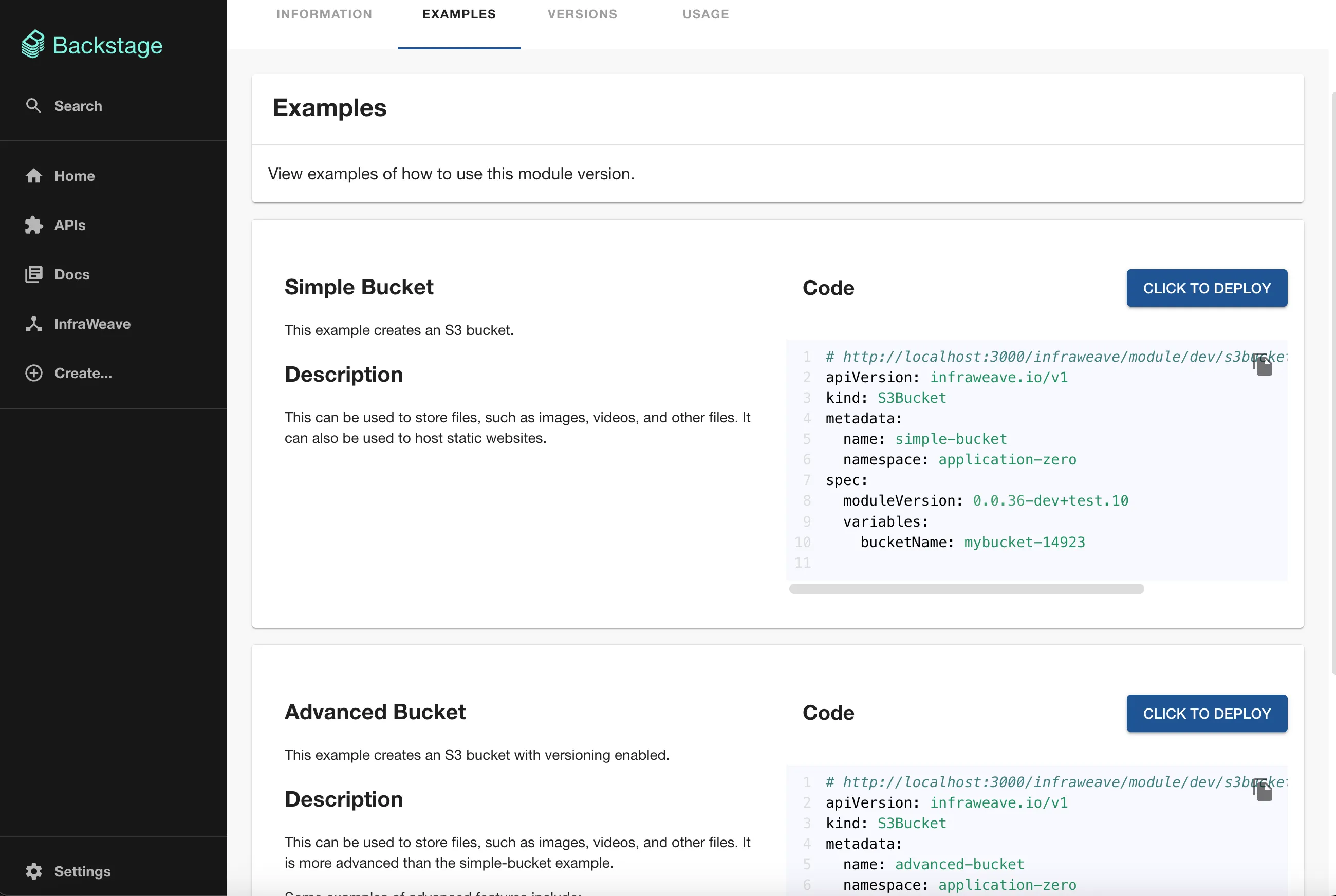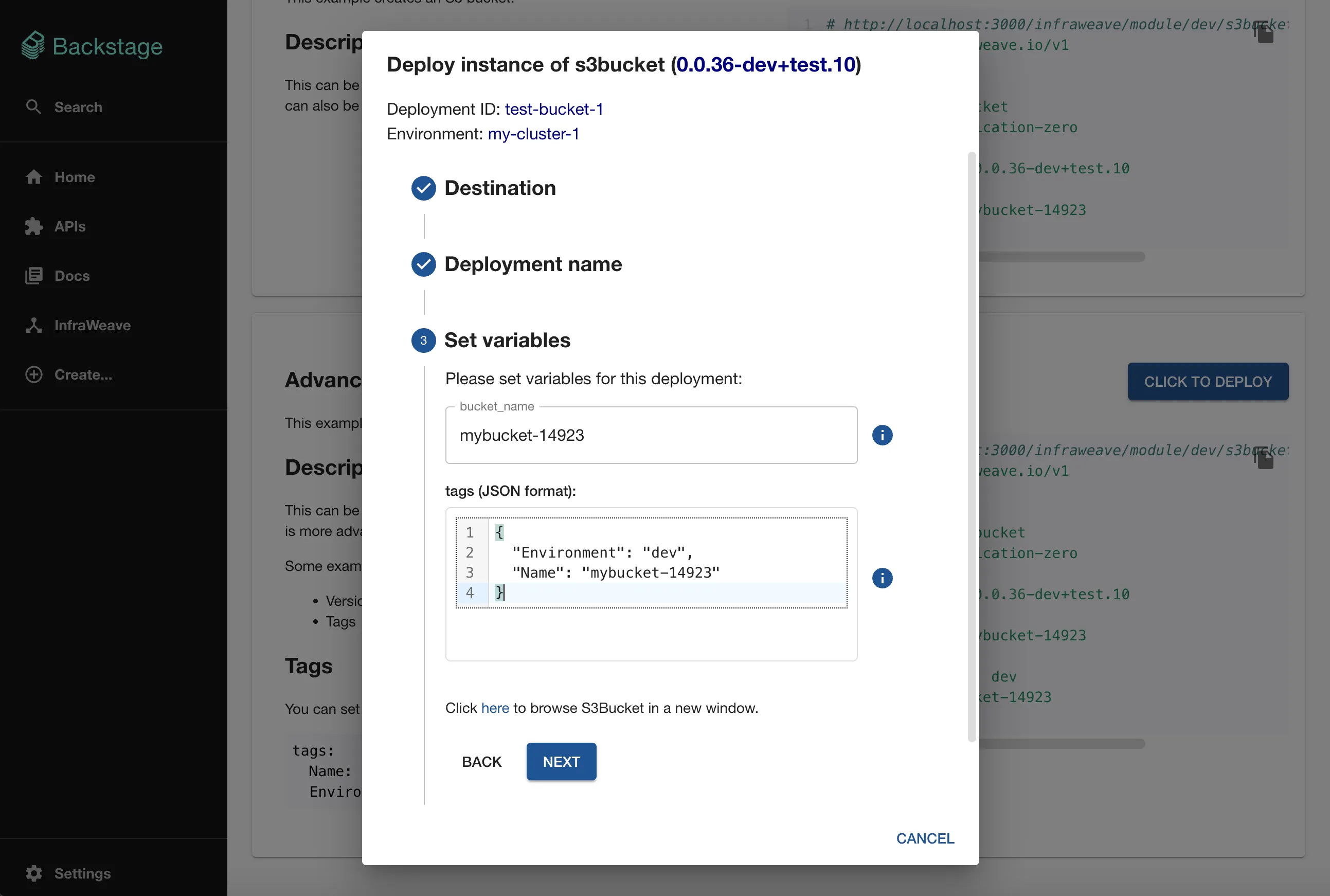Examples
Both Module and Stack support the parameter examples.
Each example-item requires 3 fields:
- name - Identity of the example in the module
- description - Brief summary about this examples (markdown, so you can put links, images etc)
- variables - Each variable you specify will guide the user how it should be entered. It should contain at least all “required” variables. Any non-required variable you don’t specify here will not be shown in the example, and will help making it easier for the user.
Here is an example of adding a simple and an advanced example for a module (notice the difference between Module and Stack below)
apiVersion: infraweave.io/v1kind: Modulemetadata: name: VPCspec: version: 0.1.5-alpha.1 reference: https://github.com/infraweave-io/example/module/vpc description: | Description about VPC here... examples: - name: simple-vpc variables: vpc_name: replace-me description: | # Simple Bucket This example creates a simple VPC.
## Description This creates a VPC with private /26 subnets in two availability zones. - name: advanced-vpc variables: vpc_name: replace-me cidr_block: 10.0.0.0/24 availability_zones: 3 enable_internet_gateway: true enable_nat_gateway: true enable_vpc_endpoints: s3: true dynamodb: true enable_flow_logs: true flow_logs_destination: cloudwatch security_groups: web_servers: description: Security group for web servers ingress: - protocol: tcp port: 80 cidr: 0.0.0.0/0 - protocol: tcp port: 443 cidr: 0.0.0.0/0 egress: - protocol: -1 port: all cidr: 0.0.0.0/0 database: description: Security group for database servers ingress: - protocol: tcp port: 3306 sourceSecurityGroup: webServers egress: - protocol: -1 port: all cidr: 0.0.0.0/0 tags: Name: myvpc-14923 Environment: dev description: | # Advanced Bucket
## Description This can be used to set up an advanced version of the VPC with much more options
### Some examples of advanced features include: - **NAT Gateways**: Ensures that instances in private subnets can access the Internet securely without exposing them directly. - **VPC Endpoints**: Provides secure and scalable connections to AWS services without traversing the public Internet. - **Flow Logs**: Facilitates monitoring and troubleshooting by capturing detailed information about network traffic. - **Enhanced Security Groups**: Implements granular access controls between different tiers of the application (e.g., web and database servers).Purpose
These examples serves two purposes:
- Describes how it is intended to use. In combination with Backstage it will automatically create a guided deployment
- Template testing. These examples can be automatically set up as readymade regression-tests in pipelines for the
Module/Stack
Variables
There is an important difference between Module and Stacks:
Module
Module examples are written with terraform code in mind, and you most likely tested locally running terraform code, hence examples uses snake_case to make it easy to port:
examples: - name: advanced-bucket description: | # Some description here variables: bucket_name: mybucket-14923 tags: Name: mybucket-14923 Environment: devStacks
Stack examples are written from the perspective of an application team only exposed to the claims, where users likely have several working module deployment claims, and want to make it an established Stack, hence examples uses camelCase to follow the deployment manifest convention:
examples: - name: bucketcollection description: | # Some description here variables: bucket1a: # Input for claim named "bucket1a" bucketName: my-temp-bucket1a bucket2: # Input for claim named "bucket2" bucketName: another-bucket1a tags: Name: mybucket-14923 Environment: devBackstage
Backstage has great templating support for projects, InfraWeave adds an extra dimension by creating deployments with variable support inferred by the terraform module - no documentation needed, always up to date with the version you click! (including descriptions of the variables)



